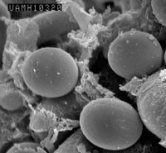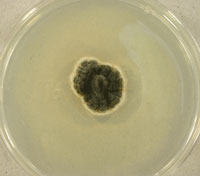Other Fungi
Description of the yellow rot pathogen of the medicinal mushroom Ganoderma lucidum
With colleagues in Korea, we identified a pathogen of cultivated
Ganoderma lucidum.

Ascospores shown by
scanning electron microscopy
Ganoderma lucidum is a mushroom widely known for its medicinal properties and it is consumed as health food in Asia where it is known as Yeongii in Korea, Lingzhi in China, and Reishi in Japan. The mushroom is widely cultivated on oak logs in greenhouses. In Korea a fungal disease called yellow rot resulted in destructive lesions on the mushrooms and the causal agent became known as the yellow rot pathogen (YRP), but the identity of the fungus was uncertain. By means of morphological features, pathogenicity tests and phylogenetic analyses of DNA sequences, we found that the YRP isolates grouped with an ascomycete Xylogone sphaerospora and with a hyphomycete, Arthrographis cuboidea, but was distinct from either species. Scytalidium lignicola, the type species of Scytalidium, was also related but more distantly. We described the YRP pathogen as the new species Xylogone ganodermophthora and showed by pathogenicity tests that only this species was capable of causing symptoms in Ganoderma lucidum. Read more about G. lucidum
Plant root associated fungi (Leotiomycetes).
Isolation of endophytes from ericoid mycorrhizas by S.Hambleton (Ph.D., Alberta; R. Currah) revealed a group of culturally similar sterile isolates reported

Meliniomyces vraolstadiae

Meliniomyces variabilis
in the literature as Variable White Taxon (Can J Bot 75:1570–1581, 1997). When these isolate were deposited in UAMH, similarites were noted with isolates from spruce mycorrhizas deposited earlier as Sterile white I by R.C. Summerbell (Can J Bot 67:1085–1095, 1989). The new genus,
Meliniomyces Hambleton & Sigler, having phylogenetic relationship to the well-known mycobiont
Rhizoscyphus ericae (=
Hymenoscyphus ericae), was described in a special issue of
Studies in Mycology focusing on root associated fungi. In addition to isolates obtained from roots of the Orchidaceae, Pinaceae, Betulaceae and Salicaceae,
M. variabilis was shown to be represented by many unnamed sequences in GenBank. Two other species were described as
M. bicolor and
M. vraolstadiae, the latter named after Dr. T. Vrålstad who defined the "
Hymenoscyphus ericae aggregate" (See also Vrålstad et al. New Phytol 145: 549–563, 2000; 155:131–148, 2002). Additional
collections of
Meliniomyces species were obtained in 2009-2010. The genomes of two strains acquired from Dr. G. Grelet have been sequenced (
Meliniomyces bicolor strain E = UAMH 11274 and
Meliniomyces variabilis strain F (GT02V1) = UAMH 11265.
Members of the genus Cryptosporiopsis are also increasingly recognized as common endophytes in plant roots. Isolates from ericaceous plants including Vaccinium species and Gaultheria shallon (salal) from British Columbia were described in Studies in Mycology (2005) as new species, Cryptosporiopsis ericae Sigler and C. brunnea Sigler, based on morphological features and analysis of DNA sequences. Both species were obtained only from surface-sterilized roots but little was known about their functional roles. A study by Wang et al (2007) identified C. ericae and Cryptosporiopsis radicicola as common endophytes in the roots of apparently-healthy Populus tremuloides growing in various soils and moisture regimes in Alberta. On artificially inoculated aspen roots, the hyphae of C. ericae only occasionally penetrated into the host epidermis.
Another Canadian study sampled Vaccinium membranaceum at four elevations in the mountains of east-central British Columbia (Gorzelak et al, Fungal Ecology 2012; 5:36-45). The authors determined that Cryptosporiopsis ericae was among the four most common root endophytes together with Phialocephala fortinii, Rhizoscyphus ericae and Meliniomyces species. C. ericae occurred in plants at all elevations but was more frequent at lower elevations. Based on data from GenBank sequence deposits, C. ericae appears to be widely distributed, occurring in roots of ericaceous, coniferous, deciduous and orchidaceous plants from Canada, China, Taiwan and Europe. In contrast, C. brunnea appears to be a rare taxon, thus far known only from the single Canadian isolation.
See publications